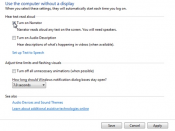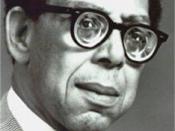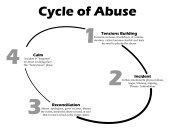According to the Microsoft Online Encyclopedia, there were 166,232 confirmed cases involving American children who were physically abused by their parents and 66,293 cases involving emotional abuse in 2001. In Robert Hayden's "The Whipping," the narrator relives his own tragic experiences as he witnesses a boy being physically and verbally abused. The poem illustrates a cycle of abuse that is perpetuated by both the narrator and the woman. One can infer that not only were the boy and the narrator both victims of abuse, but the woman was a victim as well.
The fact that the woman is physically and verbally abusing the boy is made obvious in the first three stanzas. In the first stanza, the narrator states that the woman is beating the boy "again," indicating that this happened on a regular basis (2). One might guess that the boy is constantly misbehaving and is just being punished again.
However, after further reading it becomes evident that the woman is not simply punishing the boy, but she is abusing him. Even though the boy pleads with the woman for compassion, she "strikes and strikes the shrilly circling / boy until the stick breaks / in her hand" (6, 9-11). The woman is full of rage and is hitting him out of anger. She shouts to the neighborhood "her goodness and his wrongs" (3-4). She is demoralizing the boy in order to make herself feel better about her actions and to make him feel like he deserves to be whipped.
Towards the middle of the poem, the narrator is reminded of the abuse that he suffered as a boy. He says that the boy's "tears are rainy weather to wound like memories"(11- 12). The narrator seems to be having a "flash- back," and he describes the beatings he received and the emotion he felt. He felt fear that is "worse than the blows that hateful / words could bring" (15-17). It is both sad and unfortunate that the narrator is able to relate to a situation such as this.
The end of the poem reveals evidence that the woman had been a victim of child abuse too. After she finishes beating the boy, she "leans muttering against / a tree exhausted, purged - / avenged in part for lifelong hidings / she has had to bare" (21- 24). In other words, she feels better after beating the boy. She has hurt and anger stored inside of her as a result of her own traumatic experience. She is "lifting herself up" by "putting the boy down." It is a well-known fact that victims of child abuse often grow up to abuse their own children. "Studies show that some 30 percent of abused children become abusive parents, whereas only 2 to 3 percent of all individuals become abusive parents" (Encarta).
It is obvious that everyone in "The Whipping" is a victim of child abuse. One question remains: why do both the narrator and the woman allow the vicious cycle to continue? As long as the cycle continues, there will never be peace or healing in their homes. In order for a physical wound to heal, it must be cared for. The same applies to emotional wounds.
If not cared for properly, physical and emotional wounds can get worse.
"Child Abuse." Microsoft Encarta Online Encyclopedia 2003. www.encarta.msn.com Hayden, Robert. "The Whipping." Literature:, Structure, Sound and Sense. Ed Thomas R. Arp and Greg Johnson. Fort Worth: Harcourt, 2001. 727.





